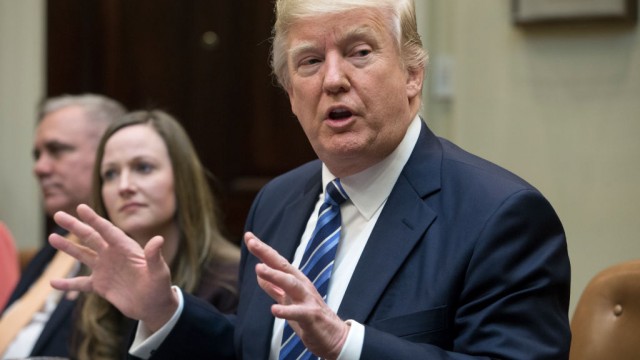Trump, start fixing health insurance markets without Congress
 The House GOP may have abandoned its attempt to replace the Affordable Care Act (for now), but the market for individuals and small employers to purchase health insurance remains deeply dysfunctional and in urgent need of reform. By rolling back a recently-issued insurance regulation and waiving some of the ACA’s penalties, the Trump administration can shift the bulk of the insurance market onto a well-functioning track while better-targeting subsidies at those in the greatest need.
The House GOP may have abandoned its attempt to replace the Affordable Care Act (for now), but the market for individuals and small employers to purchase health insurance remains deeply dysfunctional and in urgent need of reform. By rolling back a recently-issued insurance regulation and waiving some of the ACA’s penalties, the Trump administration can shift the bulk of the insurance market onto a well-functioning track while better-targeting subsidies at those in the greatest need.
Insurers have struggled to finance their obligations under the ACA. As a result, networks have narrowed, premiums have soared an average of 75 percent, and annual deductibles above $12,000 are now common for family plans. Four of the five largest insurers have sharply cut back on their exchange participation, and there are currently only 12 million enrollees — 11 million fewer than were initially estimated for 2017.
President Trump has promised to reverse the increase in healthcare premiums and reduce the number of Americans uninsured without adding to the deficit. In order to do this, it is necessary to increase the efficiency of health insurance markets and to better target the ACA’s subsidies at individuals who are unable to afford their expected costs of care.
Although the congressional GOP was prevented by budget reconciliation rules from improving insurance regulations, Secretary Price can do so — and should treat the exchanges as de facto high risk pools, by allowing the sale of more flexible and affordable plans outside of them.
The ACA sought to make health insurance affordable for those with pre-existing conditions by requiring insurers to make plans available on the same terms to the sick and the healthy. By fixing premiums many times above the healthcare costs that the healthy expect to incur, but well below the levels that the chronically ill are sure to need, it has established a dynamic whereby insurers endeavor to avoid selling plans to the sick and the healthy try to avoid purchasing them.
The ACA’s mix of carrots (subsidies) and sticks (taxes), however, has proven inadequate either to attract appealing insurance plans and or to induce healthier individuals to buy them. As a result, the enormous cost of subsidizing the care of those with pre-existing conditions has become concentrated in the premiums of the 5 percent of Americans who still feel obliged to purchase health insurance on the individual market.
This dysfunction has arisen by conflating two separate functions: insuring the healthy against the risk of illness or accidents, and subsidizing the chronically ill for costs that they already know they will face. Yet, by forcing all to buy equivalent plans from the exchange, the ACA has prevented the healthy from purchasing plans to insure themselves at a cost proportionate to the risks that they face, and failed to ensure that subsidies are well-focused on the smaller pool of individuals who truly need them.
Most Americans do not want subsidies, they just want reasonably-priced insurance plans. A remnant of this survives in the short-term insurance market, which was exempt from the ACA’s regulatory reforms. These offer actuarially-priced plans starting at $20/month, with premiums varying according to individual choice of cost-sharing arrangements.
Until a regulation hastily-issued by the Obama administration on Oct. 31, a week before the election, these plans were gaining popularity as a viable source of affordable coverage — despite the requirement that individuals enrolled in them still pay the penalty for non-enrollment in the ACA’s exchanges. This regulation reduced the maximum duration of coverage under these plans from 364 days to 3 months, and prevented insurers from guaranteeing the renewability coverage to enrollees.
The Trump administration should reverse this course by repealing these restrictions on short-term insurance, and by waiving the mandate penalty for individuals enrolled in such plans. They could then operate as a well-functioning insurance market for the vast majority of individuals uncovered by employers or public entitlements. The exchanges should be allowed to continue offering subsidized coverage — but with a much-diminished pool of enrollees, this subsidy would become much better-focused on the small subset of beneficiaries who truly need it.
This approach would remedy the core ill of the insurance market without new spending, new legislation, or unprecedented executive action. As plans become available on terms that are attractive to the healthy, the number uninsured would likely fall. The exchanges would shrink to become high-risk pools. Only temporary risk-corridors to support exchange plans may be required to ensure a smooth transition, as they likely will be to stabilize the marketplace under any course.
But a stable and predictable risk profile of enrollees, essentially reinsured by the Federal government, would ensure that exchange plans could profitably be tailored to the distinctive care management needs of the chronically ill population — as has been the case with Medicare’s Special Needs Plans.
As a result, Americans would be able to retrieve the affordable pre-ACA plans that met their needs — but individuals with pre-existing conditions would be able to enjoy exchange plans that more fully to live up to their promise too.
BY CHRIS POPE, OPINION CONTRIBUTOR - 04/10/17 02:00 PM EDT
Chris Pope is a senior fellow in health policy at the Manhattan Institute, which is celebrating its 40th anniversary this year.